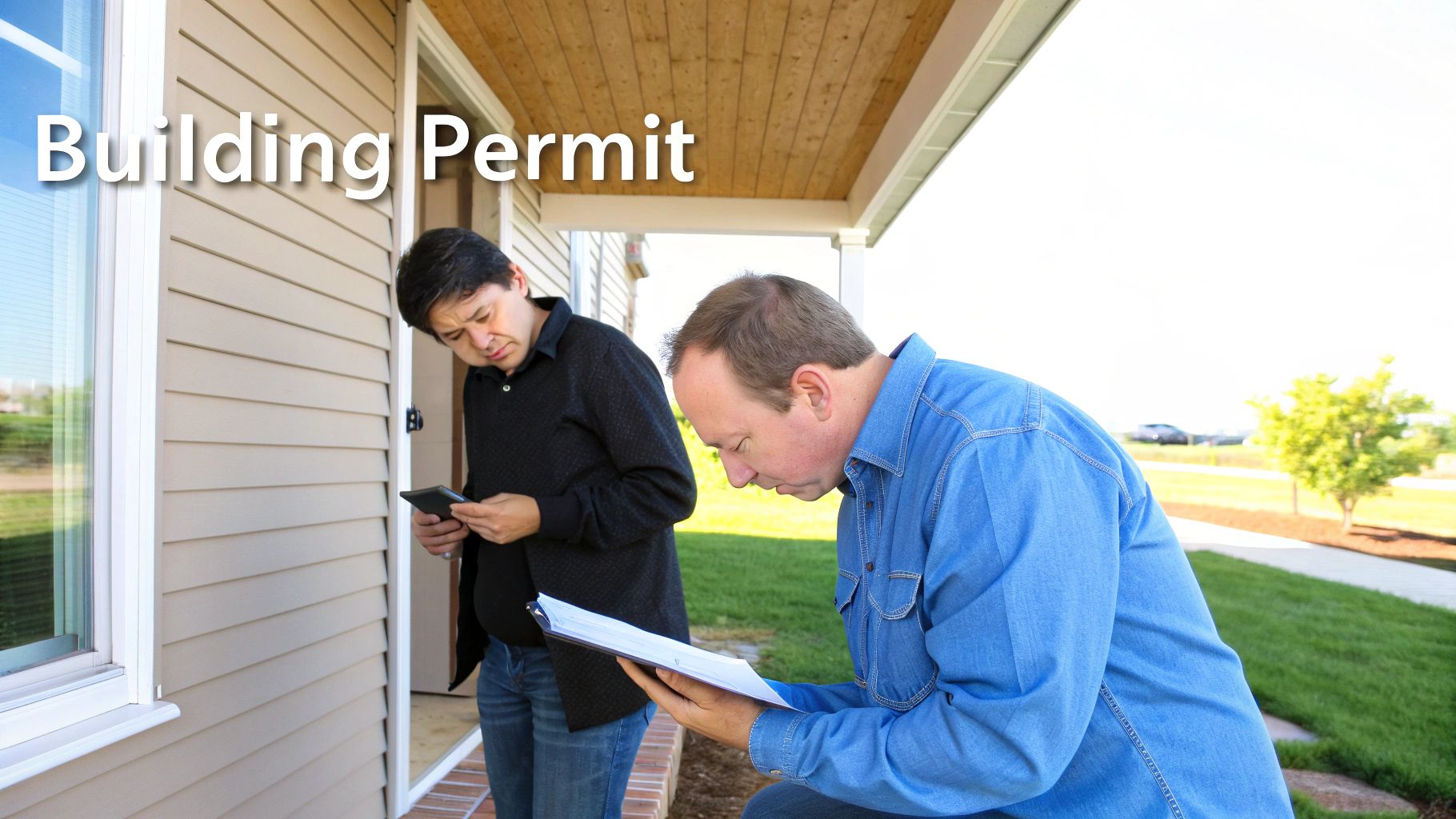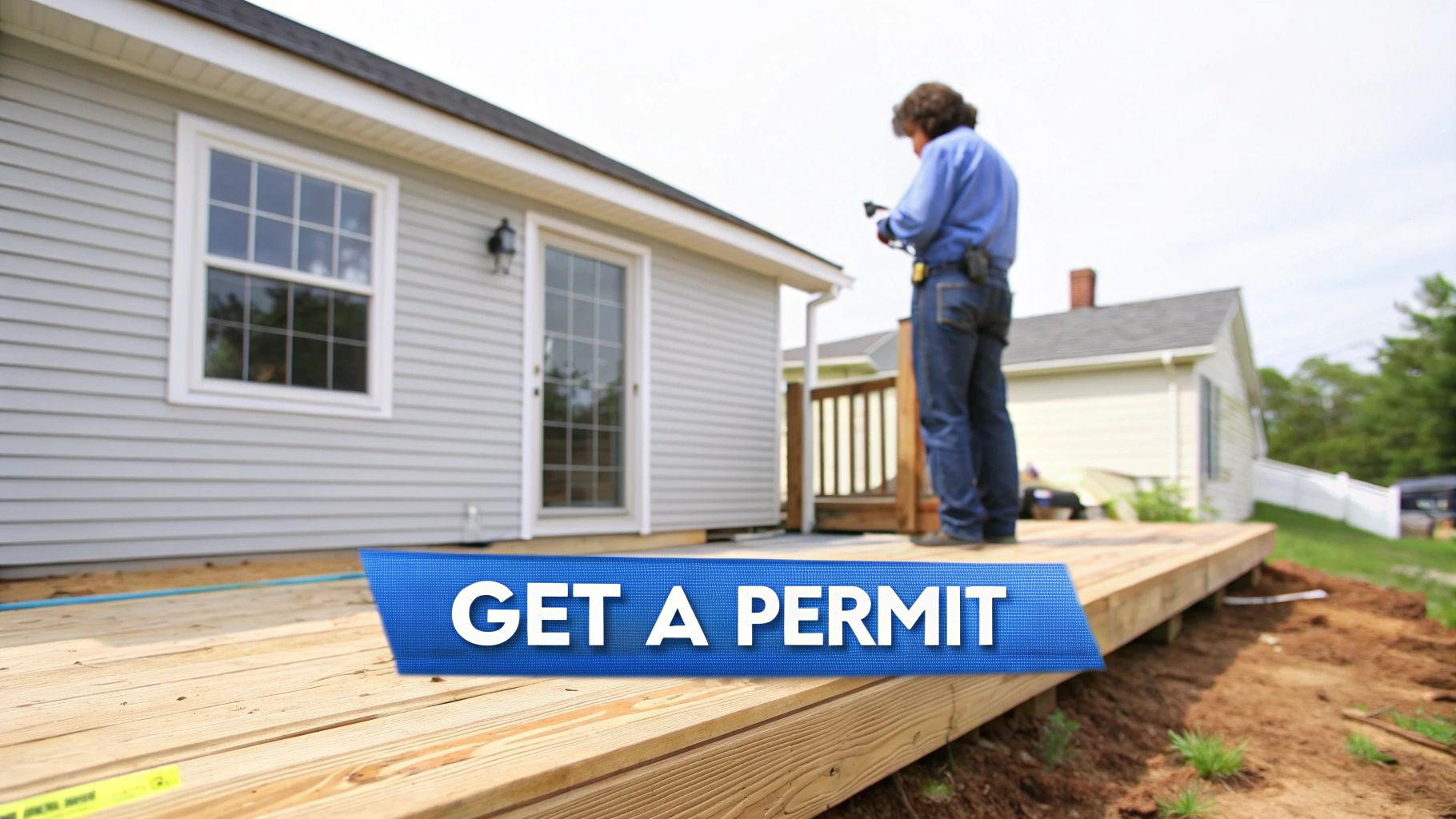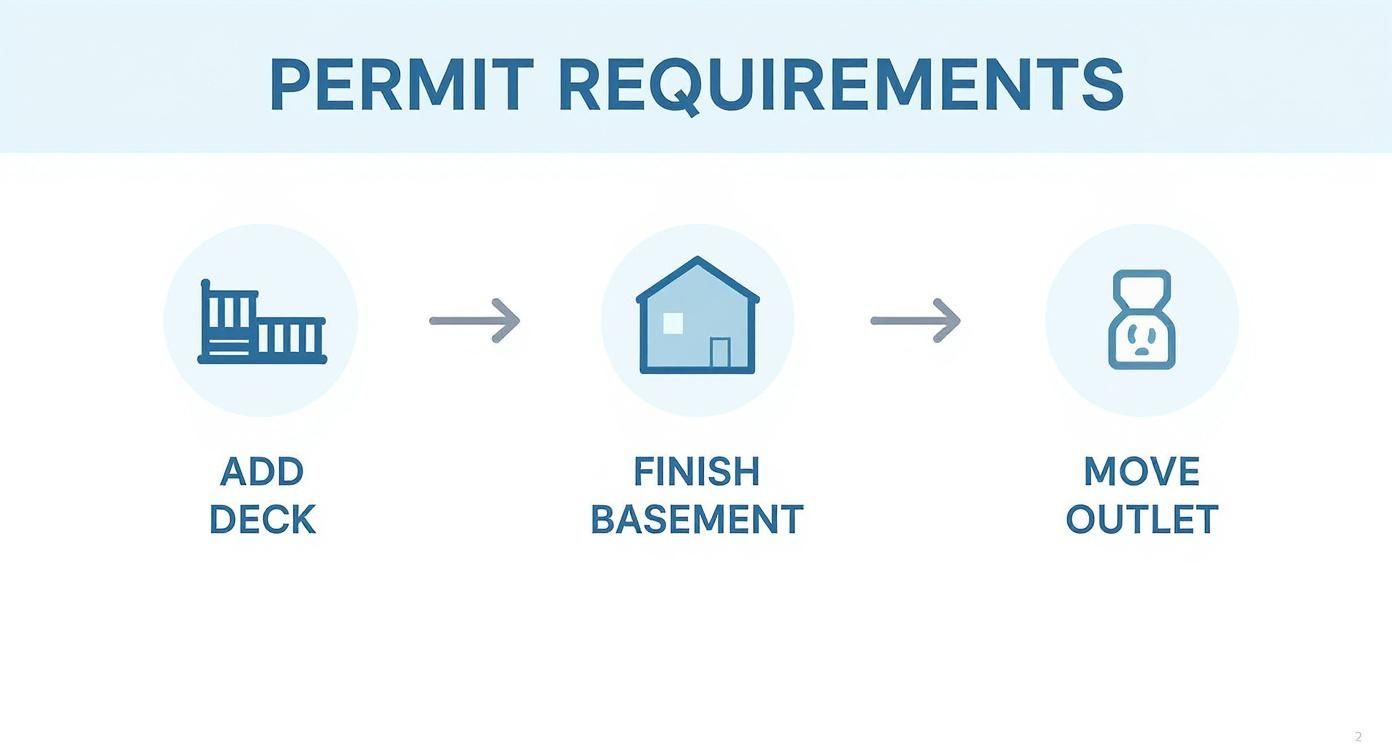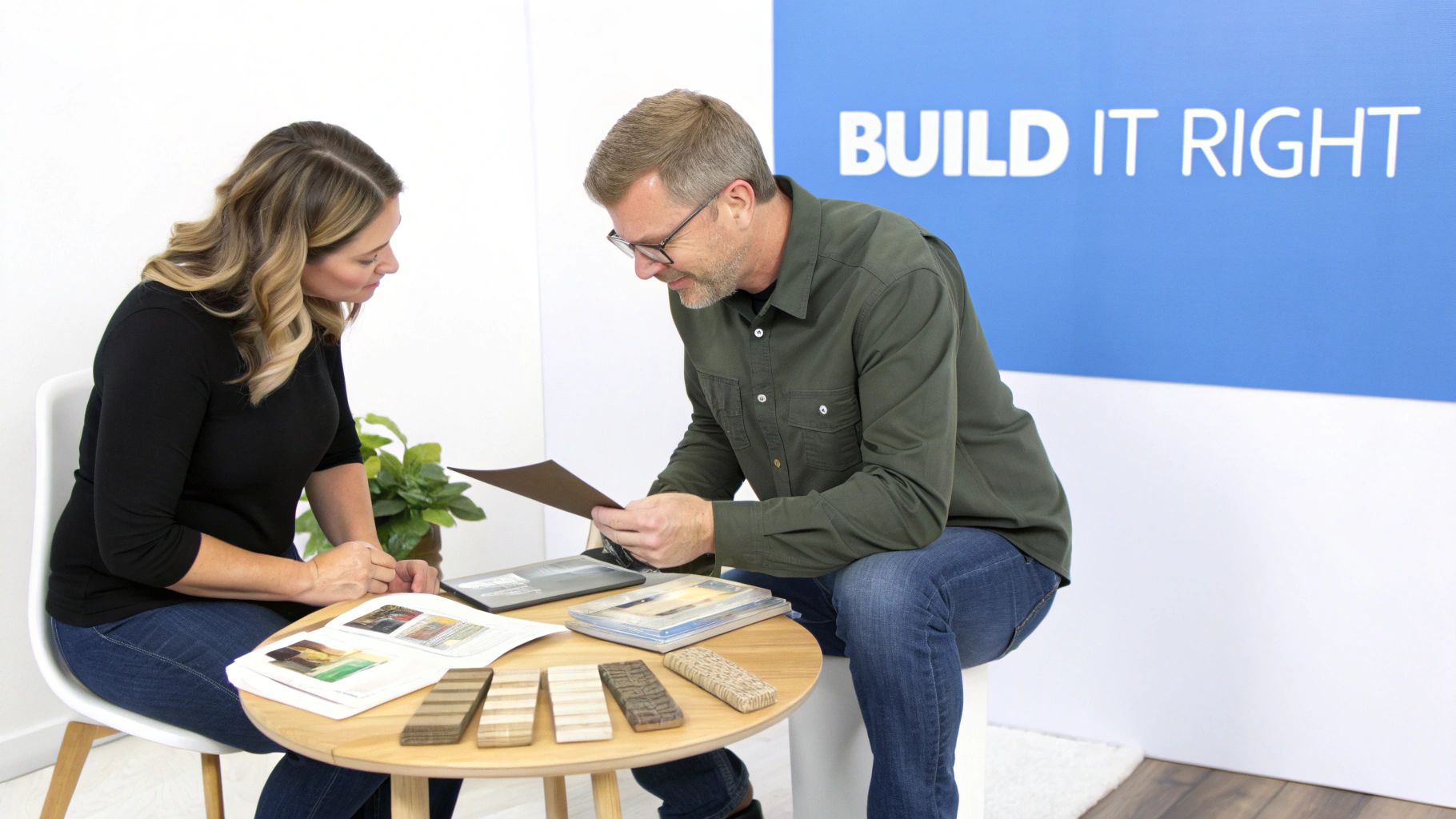What Is a Building Permit Explained for Homeowners
- Justin McCurdy

- Oct 25
- 15 min read
So, what exactly is a building permit? Let's cut through the jargon. Think of it as an official permission slip from your local government, whether you're in Baltimore County, Harford County, or anywhere else in Maryland. It’s their way of giving your construction project a thumbs-up.
This document confirms that your plans are solid, safe, and follow all the local rules and building codes.
The Official Stamp of Approval Explained

Here's a friendly analogy I like to use: imagine you're baking a cake for a big competition. You wouldn't just eyeball the ingredients and hope for the best, would you? Of course not. You’d follow a trusted recipe to make sure it not only tastes great but is also safe for everyone to eat.
A building permit is the "recipe" for your home improvement project. It’s not just bureaucratic red tape; it’s the framework that ensures your new deck, finished basement, or addition meets critical safety and construction standards. For a practical example, think about building a new deck. A permit ensures it's attached to your house correctly and can safely hold the weight of your family and friends during a summer cookout.
This official approval is your green light to start construction, alteration, or even demolition. The core purpose is to make sure everything lines up with local standards for land use, zoning, and most importantly, public safety. This covers everything from structural integrity and fire protection to environmental regulations. You can get a sense of the economic importance of this process and see a more technical definition of what a building permit is on tradingeconomics.com.
For a quick overview, let's break down the key components of a building permit and why each one is so important.
Building Permit Quick Facts
Aspect | Why It Matters |
|---|---|
Official Authorization | It's the legal document from your local authority (e.g., your county's permit office) that allows construction to begin. Without it, you're building illegally. |
Code Compliance | This is the big one. It confirms your project plans meet the minimum safety standards set by local and national building codes. |
Inspection Process | The permit triggers a series of inspections at key project milestones. This ensures the actual work matches the approved plans, especially for critical systems like electrical and plumbing. |
Public Record | A permit creates an official record of the work done on your property, which is crucial for property value, insurance, and future sales. |
As you can see, a permit is much more than a piece of paper—it's a system designed to protect you, your family, and your investment.
Why It's More Than Just Paperwork
It’s easy to view getting a permit as a hassle, but it’s a fundamental part of responsible homeownership that provides several layers of protection.
Safety First: This is non-negotiable. An inspector will check the work at key stages to confirm it meets code. For example, during an electrical inspection, they'll make sure the wiring for your new recessed lighting won't overheat and cause a fire.
Protects Your Investment: Unpermitted work is a huge red flag when you decide to sell. It can scare away potential buyers, complicate financing, and may not even be covered by your homeowner's insurance if something goes wrong.
Ensures Quality Work: The permit process forces you (and your contractor) to create sound plans before a single nail is hammered. This simple step helps prevent costly mistakes and ensures the project is built to last.
This isn't just a Maryland thing, either. The need for this kind of oversight is recognized globally, though the specifics certainly change from place to place. To see how requirements vary by region, you can look at examples like the regulations for building permits in the UAE.
Whether you're in White Marsh, Maryland, or halfway across the world, a permit is a universal sign of a job done right.
Why You Absolutely Need a Building Permit

Let's be honest, when you're excited about a home project, the idea of dealing with paperwork can feel like a real drag. Skipping a permit might seem like a clever shortcut to save a bit of time and money, but trust me, it's one of the biggest gambles you can take as a homeowner.
Getting that official stamp of approval is non-negotiable for any significant project. It's not just about jumping through bureaucratic hoops—it's about protecting your family, your finances, and the very structure you live in.
Think of a building permit as a safety net. It’s the official process that ensures your project is structurally sound, the wiring won't be a fire hazard, and the plumbing won't spring a leak down the road. When you pull a permit, you’re inviting a neutral, third-party expert (the inspector) to verify that the work meets a bare minimum of safety standards. Their only job is to protect you.
Protecting Your Biggest Investment
Your home is likely your biggest asset, right? Now, imagine you've built a gorgeous new deck, the perfect spot for summer barbecues. A few years later, you decide to sell. Any decent home inspector or buyer’s agent will spot that unpermitted work from a mile away.
Suddenly, your smooth sale hits a major snag. You might be forced to slash your asking price, get the work permitted retroactively (which is a huge pain), or, in a worst-case scenario, tear the whole thing down.
Here’s what you’re really risking when you skip the permit office:
Stop-Work Orders: If the local authorities in Baltimore County or Harford County get wind of your project, they can slap a stop-work order on your property. This legally forces all construction to a screeching halt until you sort out the permits, often with penalties tacked on.
Hefty Fines: Getting caught almost always results in fines, which can easily be double or triple the original permit fee. That "money-saving" shortcut just became a costly mistake.
Insurance Nightmares: This is the big one. If a fire starts in an unpermitted kitchen renovation or a poorly built deck collapses, your homeowner's insurance has every right to deny your claim. That leaves you holding the bag for all the repair costs and any potential lawsuits.
The permit process isn't meant to be a roadblock; it's designed to give you confidence. It’s the formal proof that your home improvement project isn't just beautiful, but also safe, compliant, and built to last.
The Long-Term Peace of Mind
At the end of the day, a building permit buys you peace of mind. There’s a quiet confidence that comes from knowing your new sunroom or finished basement was built the right way. It creates a clean, official record for your home that pays dividends for years to come.
When you're building a new home from the ground up in communities like White Marsh or Edgewood, the great news is that the builder handles all of this for you. We take care of the permitting from day one, ensuring everything is up to code before you even move in.
This leaves you free to focus on the fun stuff—making the house your own. With my hands-on service and unique visualizer tools, you can dive right into choosing the flooring, countertops, and cabinets that make your dream home a reality, all while knowing the foundation beneath it is rock-solid.
So, When Do I Actually Need a Building Permit in Maryland?
This is the big question, right? It’s not like you need to get official permission for every little thing you do to your house. The good news is, you don’t.
The general rule of thumb is pretty straightforward: if your project messes with your home's structure, or its electrical, plumbing, or mechanical guts, you’re going to need a permit. It’s all about making sure the work is safe and won’t create a disaster down the road. Simple cosmetic updates? You're usually in the clear.
The Big Stuff: Structural and System Changes
In Maryland counties like Baltimore, Harford, and Prince George's County, you'll definitely need a permit for any project that adds on to your home or changes its core structure. We're talking about more than just a new coat of paint here.
For instance, if you're thinking about expanding your living space with an addition, that's a major undertaking. To get your head around a project that big, our complete guide on how to plan a home addition is a great place to start. It walks you through everything from the initial design ideas to getting the job done.
Here are some classic examples of projects that will have you heading to the permit office:
Building a deck. A deck isn't just a wooden platform; it's a structure attached to your house that has to support a lot of weight. A permit ensures it's built to code and won't collapse during your first barbecue.
Finishing a basement. Turning a concrete box into a livable space involves putting up walls, running electrical wires, and often adding plumbing. All of that needs to be inspected to make sure it's a safe place for your family to hang out.
Removing or moving walls. This is a huge one. Knocking down a wall, especially if it’s load-bearing, can seriously compromise your home’s structural integrity. You need a professional to sign off on that.
Adding a new window or door. Cutting a new hole in the side of your house is a structural change, plain and simple. It needs a permit.
Don't Forget Electrical and Plumbing Upgrades
Beyond the major construction jobs, most electrical and plumbing work also requires a permit. This is purely a safety issue. You're trying to prevent fires and catastrophic water damage, so cutting corners here is a really bad idea.
These projects almost always require a permit:
Installing a new water heater. This job involves hooking up plumbing lines and, depending on the model, electrical or gas lines too. It’s a critical piece of equipment that needs to be installed correctly.
Adding new outlets or circuits. Expanding your home's electrical system needs to be done right to avoid overloading circuits and creating a fire hazard.
Moving plumbing fixtures. Want to relocate your toilet or sink? That means re-routing the supply and drain lines, which have to be inspected to ensure they work properly and don't leak.
Installing permanent fixtures like solar panels. Going green with solar is fantastic, but it's a complex installation. For a closer look at what's involved, you can check out these solar panel permit requirements.
To make it even clearer, here's a quick cheat sheet comparing common projects.
Permit Needed vs. No Permit Needed
A quick comparison of common home projects to help you determine if a permit is likely required in Maryland.
Project Example | Permit Typically Required? | Why? |
|---|---|---|
Finishing a basement | Yes | Involves structural, electrical, and often plumbing work. |
Painting a bedroom | No | It's a purely cosmetic, surface-level change. |
Building a new deck | Yes | A deck is a new structure attached to your home. |
Replacing a faucet | No | Simple fixture swap with no changes to the plumbing lines. |
Removing a load-bearing wall | Yes | This directly impacts your home's structural integrity. |
Re-roofing your house | Yes | A roof is a major structural component; proper installation is critical. |
Installing new kitchen cabinets | No | As long as you aren't moving the sink or appliances. |
Adding a bathroom | Yes | Involves major plumbing, electrical, and structural changes. |
This table should give you a better gut feeling for what triggers the permit process. When in doubt, it's always smartest to just call your local building department and ask.
When Can You Skip the Permit Office?
So, what about all the smaller weekend projects? The great news is that tons of common home improvement tasks are considered cosmetic and don't require any official paperwork.
The key difference is that these projects don't alter your home's structure or its essential systems. They are surface-level changes that refresh your space without impacting its core safety.
You can usually go ahead and skip the permit process for jobs like these:
Painting interior walls or your home's exterior siding.
Replacing a faucet or showerhead in the exact same spot.
Installing new flooring like carpet, laminate, or hardwood.
Replacing kitchen cabinet doors or putting in new countertops (as long as you don't move the sink or major appliances).
How to Navigate the Permit Application Process
Staring down the permit process can feel a little overwhelming, but it’s really not so bad when you break it into bite-sized pieces. Think of it like following a recipe. If you take it one step at a time, you’ll get to the finish line without much of a headache.
This whole system isn't new, by the way. The idea started way back in 19th-century European cities as a way to deal with fire safety and basic sanitation. As buildings got more complicated, the rules evolved right along with them. If you’re a history buff, you can get a deeper look into the history of building permit regulations on tradingeconomics.com.
Let’s walk through the modern-day journey, from figuring out where to go to getting that final sign-off.
Finding Your Local Office and Gathering Documents
First up, you need to find your local permit office. This is totally dependent on where you live. For folks in White Marsh, you’ll be working with Baltimore County, while those in Edgewood will head to Harford County's office. The easiest way to find yours is to just Google "[Your County] building permit office."
Once you've located the right department, it's time to get your paperwork in order. This is where the specifics of your project really matter.
Completed Application Form: This is the starting point. You can almost always find and download this form directly from your local government's website. Be thorough and make sure every line is filled out correctly.
Construction Drawings or Blueprints: These are the heart of your application—the detailed plans that show exactly what you want to build, right down to the dimensions and materials. Need a little help deciphering them? Our guide on how to read house blueprints for homebuyers can be a real lifesaver.
Site Plan: Think of this as a map of your property from a bird's-eye view. It needs to clearly show where the new construction will sit in relation to your property lines and any existing buildings.
Fee Payment: Yep, there’s a fee. You’ll need to be ready to pay this when you submit everything. The cost will change based on how big and complex your project is.
This infographic lays out the basic flow for some common projects that need a permit.

As you can see, whether you're building a new deck, finally finishing that basement, or doing some electrical work, the core steps are pretty much the same.
The Review and Inspection Stages
After you've submitted your application and all your documents, your project enters the plan review stage. This is where a county plans examiner combs through every detail to make sure your project is up to code and follows all the local zoning rules.
This isn't an overnight thing. It can take anywhere from a few weeks to a couple of months, mostly depending on how long the queue is at the permit office.
Once your plans get the thumbs-up, you'll be issued your official building permit. That’s your green light—you can finally start construction!
But hold on, you're not done just yet. The last piece of the puzzle is the inspection phase. As you hit key milestones in your project—like when the framing is up or the electrical wiring is roughed in—you have to schedule an inspection. A county inspector will come out to the site to physically check the work and make sure it matches the approved plans.
Passing these inspections is non-negotiable. They're the final confirmation that your project was built safely and correctly, officially closing the loop on your permit.
Making Sense of Permit Costs and Timelines
Let's get right to it. The two questions I hear most often are, "How much is this going to set me back?" and "How long am I going to have to wait?" When we're talking about building permits, the honest answer to both is... it depends.
There's no single price tag for a building permit. The cost is directly tied to the size and scope of what you're trying to do. It’s pretty logical when you think about it: a simple permit for a small project might only cost you $50 to $200. But for a major kitchen renovation or a new addition, you could be looking at anywhere from $200 to over $1,000. The final number really boils down to your project's total value, its square footage, and just how complicated the job is.
How Much to Budget for Permit Fees
A great rule of thumb is to set aside between 1% and 2% of your total construction budget just for the permit. So, if you're planning a $50,000 basement renovation, you should expect the permit fees to fall somewhere in the $500 to $1,000 range.
Now, remember, that's just what you're paying the county. This figure doesn't include the fees for hiring professionals like architects or engineers to draw up the plans you'll need to submit with your application. One of the nice things about buying a new construction home, like in my communities in White Marsh or Edgewood, is that the builder handles all of these costs and headaches for you. If you want to see how this fits into the bigger picture, our guide to the new home construction process breaks it all down.
What Impacts Permit Timelines?
Just like the costs, the timeline for getting your permit approved can be all over the map. A straightforward job, like getting a permit to re-roof your house, might get the green light in just a couple of weeks. On the other hand, something complex like a new home addition could easily take a few months to wind its way through the system.
A few things can really influence how long you'll be waiting:
A Complete Application: This is the big one. Your best bet for a speedy approval is to submit a perfectly filled-out application with clear, detailed plans. Missing information is the number one reason for delays, hands down.
How Busy the Permit Office Is: The local offices in Baltimore County and Harford County can get swamped, especially during the busy spring and summer building seasons.
The Complexity of Your Project: The more moving parts your project has, the more time reviewers will need to spend making sure everything is up to code.
It's also smart to remember that bigger economic forces can come into play. Things like high interest rates or tariffs on building materials can slow down construction across the board, which then impacts how busy the permit offices are. You can always discover more insights on how economic trends impact permitting and what's happening in the wider construction world.
Bring Your Dream Home to Life the Right Way

Getting a handle on what a building permit is and why it matters is a huge first step for any homeowner, whether you're tackling a DIY project or building from the ground up. The best part? When you build a new home with me, you don't have to worry about a single piece of that paperwork. The builder provides high-quality homes, and I take it a step further.
I provide a hands-on service that frees you up to dive into the really exciting stuff—like designing a space that feels like you.
My approach gives you access to some incredible customization tools and visualizers. This is your chance to really bring your vision to life, picking out the perfect flooring, countertops, cabinets, and tile that show off your style. For a full rundown of what to expect, take a look at Your Ultimate New Home Construction Checklist.
Your new home is a huge milestone. My job is to make the entire process smooth and enjoyable, from the foundational permits to the final finishes you hand-select. We’ll create a space that’s not just stunning but also safe, compliant, and ready for you to make memories in.
Ready to start building a home you'll love for years? Get in touch today to explore available homes in incredible communities across Baltimore County, Harford County, and Prince George's County. I'm here to help you get started.
Got Questions? Let's Talk Permits
Even after breaking it all down, you might still have a few lingering questions about building permits. That's perfectly normal. This process can feel a bit tangled, so let's tackle some of the most common questions I hear from homeowners.
What Happens If I Get Caught Without a Permit?
Thinking of skipping the permit to save a little time and money? I'd strongly advise against it. Getting caught can unleash a whole storm of problems.
Your local authority, whether you're in Baltimore County or Harford County, will slap a "stop-work order" on your project, bringing everything to a screeching halt. Then come the fines. They're almost always double or triple the original permit fee, instantly making that "shortcut" a very expensive mistake.
In a worst-case scenario, the building inspector could even make you tear out all the work you just paid for. And trust me, trying to sell a house with unpermitted work is a nightmare—it scares off buyers and can completely derail their mortgage process.
How Long Does a Building Permit Last?
This can change a bit depending on your specific town or county, but a good rule of thumb is that a permit is valid for 180 days (six months) from the day it's issued. The key is that you have to actually start the work within that window.
To keep the permit from expiring, you just need to show that you're making steady progress. This is where inspections come in. As long as you're hitting your milestones and getting inspections signed off, your permit stays active. If the project stalls for too long, you’ll probably have to file for an extension or, worse, start the whole application process over again.
Can a Homeowner Pull Their Own Permit?
Yes, in most places, homeowners are allowed to apply for their own building permits. But—and this is a big but—you need to understand what you're signing up for.
When you sign that application as the homeowner, you're becoming the legally responsible party. You're the one on the hook for making sure every single aspect of the job meets building codes.
Look, while you can pull the permit yourself, I always recommend letting your licensed contractor handle it for any project involving structural, electrical, or plumbing work. They live and breathe this stuff. They know how to navigate the paperwork, draw up plans that will actually get approved, and manage the inspection schedule to keep things moving smoothly.
Navigating the world of home building and renovation is so much easier when you have an expert in your corner. With Customize Your Home, I handle all these complexities so you can focus on the fun part—personalizing your space. Using our hands-on service and visualizer tools, you can design the home you’ve always wanted in fantastic Maryland communities.
Ready to see how simple building your dream home can be? Find out more at https://www.customizeyourhome.com.

Comments